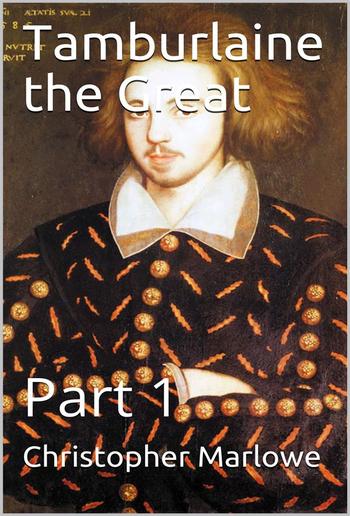
Christopher Marlowe - Tamburlaine the Great — Part 1
Tamburlaine the Great — Part 1
Christopher Marlowe
Description
Tamburlaine the Great is a play in two parts by Christopher Marlowe. It is loosely based on the life of the Central Asian emperor, Timur (Tamerlane/Timur the Lame, d. 1405). Written in 1587 or 1588, the play is a milestone in Elizabethan public drama; it marks a turning away from the clumsy language and loose plotting of the earlier Tudor dramatists, and a new interest in fresh and vivid language, memorable action, and intellectual complexity. Along with Thomas Kyd's The Spanish Tragedy, it may be considered the first popular success of London's public stage.
Marlowe, generally considered the best of that group of writers known as the University Wits, influenced playwrights well into the Jacobean period, and echoes of the bombast and ambition of Tamburlaine's language can be found in English plays all the way to the Puritan closing of the theatres in 1642. While Tamburlaine is considered inferior to the great tragedies of the late-Elizabethan and early-Jacobean period, its significance in creating a stock of themes and, especially, in demonstrating the potential of blank verse in drama, is still acknowledged.
Part 1 opens in Persepolis. The Persian emperor, Mycetes, dispatches troops to dispose of Tamburlaine, a Scythian shepherd and, at that point, a nomadic bandit. In the same scene, Mycetes' brother Cosroe plots to overthrow Mycetes and assume the throne.
The scene shifts to Scythia, where Tamburlaine is shown wooing, capturing, and winning Zenocrate, the daughter of the Egyptian king. Confronted by Mycetes' soldiers, he persuades first the soldiers and then Cosroe to join him in a fight against Mycetes. Although he promises Cosroe the Persian throne, Tamburlaine reneges on this promise and, after defeating Mycetes, takes personal control of the Persian Empire.
Now a powerful figure, Tamburlaine turns his attention to Bajazeth, emperor of the Turks. He defeats Bajazeth and his tributary kings, capturing the emperor and his wife Zabina. The victorious Tamburlaine keeps the defeated ruler in a cage and feeds him scraps from his table, releasing Bajazeth only to use him as a footstool. Bajazeth later kills himself on stage by bashing his head against the bars upon hearing of Tamburlaine's next victory. Upon finding his body, Zabina does likewise.
After conquering Africa and naming himself emperor of that continent, Tamburlaine sets his eyes on Damascus, a target which places the Egyptian sultan, his to-be father-in-law, directly in his path. Zenocrate pleads with her future husband to spare her father. He complies, instead making the sultan a tributary king. The play ends with the wedding of Tamburlaine and Zenocrate, who is crowned Empress of Persia.

